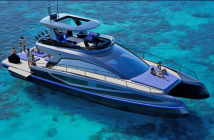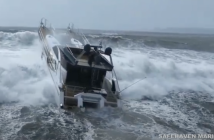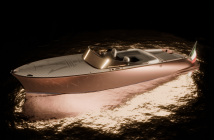I nailed it. As I jammed the throttles all the way forward, I realized this isn’t your father’s Back Cove. Actually, it isn’t like any other Back Cove ever, and I’ve driven every new model since Back Cove introduced its first one, a 29, in 2003. Back then, Sabre Yachts created Back Cove as a single-diesel, low-maintenance, user-friendly Down East cruising boat.
But now, on this brand-new Back Cove 34O, all that was ancient history. Powered by twin 300-hp Yamaha outboards, the Back Cove simply took off. As the props dug in, there was a bit of bow rise and then the new cruiser leveled off and sped ahead. In a matter of about ten seconds, the Yamaha engine gauge hovered at 36 knots, then briefly hit 37 knots, as we sped from Long Island Sound into the western entrance to Norwalk Harbor in Connecticut. This was fun!
It also was game-changing, both for Back Cove and for legitimate cruising boats. Sure, lots of dual console or center console boats go faster than 37 knots, but, as Bentley Collins, the VP of Back Cove and Sabre for sales and marketing who was on the boat with me, pointed out, “Above all, this remains a cruising boat. It goes fast, but it also is a comfortable cruising boat. It has the accommodations below of a cruising boat, and it has all the amenities of a cruising boat.”
But it doesn’t drive like a traditional cruising boat. The third person on the boat that Friday morning in September was Bob Petzold, of Petzold’s Marine Center in Portland, Connecticut. As he drove the boat in a two-to-three-foot chop and 12-knot wind on Long Island Sound, he smiled and said, “It’s like a sport boat.” Indeed.
The Back Cove 34O (the “O” is for outboards) is on the crest of a trend toward outboard power, even on traditional made-in-Maine or Down-East-style boats. Hinckley, for example, just introduced a 40-foot sport boat with three 350-hp Mercury Verado outboards. And MJM launched its 35z, with twin 300 Mercury Verados, a year ago. George Day, my Cruising Odyssey colleague, and I tested that boat last year on Narragansett Bay with MJM founder Bob Johnstone and it topped out at 38.6 knots in an unfriendly chop.
The primary driver behind the change to outboard power is customer demand. More and more people, perhaps influenced by their experience on bigger and bigger center consoles, want to go faster, even on cruising boats. Outboards do provide speed. The Back Cove 34O, for example, has an entirely new hull, but it’s built on the Back Cove 32, which was introduced two years ago. I tested that boat then, on a cruise from Rockland, Maine, where Back Coves are built, down to Portland; it topped out at 28 knots, powered by an optional 435-hp Volvo D6.
The switch to outboards, with a new hull designed by Kevin Burns, the VP for design at Back Cove and Sabre, added about nine knots. (When Back Cove tested the new 34O off Rockland in August, it hit 37.5 knots when powered by the standard twin Yamaha 300s; it hit 40.5 knots when powered by optional Suzuki 350-hp outboards.)
For the 34O, Burns developed what Back Cove calls a TRELIS (Trailing Edge Lift System) aft, which basically is a flat section about five feet long and two feet wide all the way aft, with the trim tabs outboard, to provide lift and clean water to the props. As a result, the boat’s draft is 24” to the bottom of the hull, 34” to the bottom of the skegs of the Yamaha 300s, and 35” to the bottom of the skegs of the Suzuki 350s.
Based on my experience driving the Back Cove 34O, and the earlier MJM 35z, outboards provide more than speed. They’re fun. They create a Fun Factor. The performance is indeed more like driving a sports car than it is driving the family sedan. You push the throttle, and there’s instant response. You move. You turn quickly. You feel power. Even if you’re not going to cruise all day at 37 knots, you know the power is there.
The other advantages of outboards include ease of maintenance (you don’t have to crawl around a crowded, and often hot, engine room); ease of replacement (just bolt on a new one), and ease of reaching the props if you pick up a lobster pot in the Northeast or get tangled in driftwood in the Northwest. You also can trim them up and cruise in shallow water or beach the boat for a picnic. Finally, they open up a lot of space inside the boat where the engine(s) used to be.
On the Back Cove 34O, you push a button just aft of the galley on the starboard side and the entire mid-section of the boat lifts up to reveal an enormous storage area; on this boat, there were two fold-up bikes, a SUP, fishing rods and other stuff down there, and there was still a virtual empty cavern, waiting for more. For cruising boat owners, this extra space is not to be underestimated. You could put a month’s worth of dry goods or extra clothing or spare parts down there and not worry about it.
And then there have been enormous developments in large-horsepower outboards themselves in the past few years. New, big, four-stroke outboards have become increasingly sophisticated. They performed better and better in terms of more and more horsepower, but they also became quiet; they didn’t produce smoke; they were incredibly reliable. They became competitive to inboard/outboard and straight inboard engines in many different types of boats.
“The success of the Yamaha 300 and 350 created its own market,” Collins said. “When we started Back Cove in 2003, there wasn’t a 300-hp outboard on the market. The motors now are so much bigger and better. Yamaha took what had been an inboard and IO market and created a better mousetrap.”
But the Back Cove 34O is about much more than its engines, impressive as they may be. It is a well-designed, safe, comfortable cruiser in a popular size range. From the seat at the forward end of the cockpit all the way forward, including the owner’s cabin below, the Back Cove 34O is the same as the original Back Cove 32. When the 32 was introduced in 2016, it won the Best Powerboat Under 35 Feet Award at the Newport International Boat Show. This September, the new 34O won the same award, plus the People’s Choice Award, at the same show. It’s nice to have a boat with a prize-winning pedigree.
You climb on the boat on either side and take one step down to enter the forward end of cockpit. You also can walk on the boat via the large teak swim platform on either side of the outboards; there’s a walkway in front of the outboards so you can move from side to side easily or access the outboards themselves.
A centerline door leads to the cockpit, which has L-shaped settees with varnished cherry tables on each side aft. Forward, to port, is the new seat which can be changed, by moving some cushions and employing some stainless steel levers, from facing aft, to be sociable in the cockpit, or facing forward, where it becomes part of the dinette (which also has a varnished cherry table on a stainless steel, hi-low pedestal). In the forward-facing mode, the seat can be used as part of a convertible berth at night.
The two-person forward seat on the port side also can be moved from facing forward, while underway, or aft, to become part of the dinette. It slides easily on two stainless steel rails. The helm station to starboard, with a single Stidd helm chair, has a new cherry booster step you can use if you’re a shorter person, as well as a cherry fold-down step. The new Back Cove is definitely a user-friendly boat. Visibility from the helm is excellent all around.
Just aft of the helm on the starboard side is the galley, which has everything you need for a weekend or longer cruise. The entire helm deck is protected by the hardtop, with an opening hatch overhead for more air and light. For a couple’s cruiser, it’s roomy; on the mid-Maine cruise two years ago on the 32, there were four of us moving around there, and we never felt crowded.
Below, down two steps, the owner’s cabin has an island queen bed with lots of storage and a traditional Down East Herreshoff-style interior. The head is on the port side, with a large shower to starboard. It would be easy to spend a lot of time on this cruiser. And then there’s the Fun Factor.
Specs.: LOA: 38’11”; Beam: 11’10”; Hull draft: 24”; Disp.: 17,000 lbs.; Fuel: 250 gals.; Water: 60 gals.; Power: 2×300-hp Yamaha outboards. Base Price: $385,000.
For the performance test, below, there were three people on board; the boat had full fuel and water tanks. Speeds and fuel flow were measured by the Yamaha engine gauges; sound readings were taken at the helm in dB(a). Range was calculated with a 10 percent reserve.
RPM Speed/Knots GPH Range dB(a)
1000 4 2.4 375 65
2000 8 6.6 272 70
3000 11 12.4 199 75
4000 21 23.6 200 80
5000 28 37.2 169 82
5700 37 52.4 158 86




